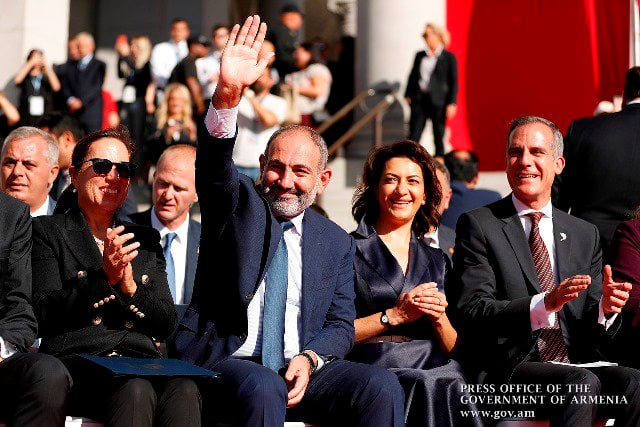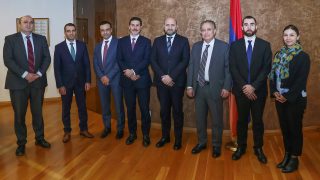
U.S. investment capital has flowed out of Armenia more than it has flowed in

The U.S. and Armenia don’t have good economic ties, and it is rare to believe that those relations will change after Nikol Pashinyan’s visit to the U.S. During his five-day visit, the Prime Minister wasn’t able to have an important meeting or reach an agreement that would allow Armenia to expect positive changes in the economic ties between the two countries.
This might sound strange, but the relations have regressed, especially after change of power in Armenia. There are no new economic programs, and trade, particularly exports, has decreased. Before change of power, more and more Armenian products were exported to the United States, and not only. However, change of power interrupted this process, and fewer Armenian products are exported now as well.
In the first quarter of 2018 (the political processes had not begun in Armenia), exports to the U.S. grew by almost 58%. After change of power, exports decreased so much that there was no growth at all by the end of the year. What’s more, there was decline, and it was as sharp as the growth in the first quarter of the year.
Based on the results of the year, supplies of Armenian products to U.S. markets dropped by 28%. Even a year-and-a-half after change of power, exports to the U.S. are still low, even after such a sharp decrease last year.
Based on official data, Armenia exported only $30.5 million in products to the U.S. during the first seven months of this year, and this is 14.3% less than the previous year, especially in the case when the first half of the previous year was not too favorable for supplies of Armenian products to external markets due to the heated domestic political processes and the instability that followed. Although the situation is incomparably calm this year, based on the statistics, there has been a rather essential decline in exports to the U.S.
The reason remains unclear, but no matter how surprising it may sound, this happened in the conditions of high economic activity, as is stated in the official statistics.
It turns out that the U.S. is less interested in Armenian products after change of power in Armenia. Otherwise, it would be hard to imagine that there would be no exports when there is a demand for Armenian products.
What happened to the change of power that took place in Armenia and the patriotic acts of Armenian Americans who welcomed the actions of the Armenian government in the period that followed change of power? Was it only about making pompous statements and giving words of advice from a distance?
Unlike exports, Armenia has seen a small increase in imports from the U.S. However, it has only been a 4% increase based on the data provided over the past 7 months, and it was predominantly due to the several imports of motor vehicles. As is known, Armenia has been importing a large number of cars recently, including cars from the United States so long as the special customs time limit for the import of vehicles from third countries hasn’t expired yet.
However, even this wasn’t able to prevent the decline in trade between Armenia and the United States. Armenia’s foreign trade turnover with the United States has dropped. In the first seven months of this year, it made up only $140 million, which is less than the foreign trade turnover of the previous year by nearly 1,000,000, and no matter how troubling it is, the decline was expressed in the form of reduction of the amounts of export.
It’s not like the economic ties between Armenia and the United States are brilliant in other sectors.
Before change of power, Nikol Pashinyan would declare that Armenians abroad are standing in line to make investments in Armenia. After change of power, there were fewer investments from the United States, but there were not many investments before change of power anyway. The net entries of direct investments are within the boundaries of $150-52 million.
The number of direct investments even dropped during the first half of this year (the net flows of direct investments have decreased by almost $2.5 million). This means that the U.S. investment capital has flowed out of Armenia more than it has flowed in.
This is the picture of the relations between the U.S. and Armenia in terms of investments, and it shouldn’t come as a surprise because the government is reaping what it has sown over the past year-and-a-half.
What’s strange is that, after all this, what is the Prime Minister relying on when he calls on Armenian Americans to come and make investments in Armenian economy? If they came, they would have come a long time ago. A year-and-a-half have passed since change of power, and this is quite enough time to make a decision to make an investment or not. If they haven’t come to this day, it means there are reasons for that. It’s clear that the former government officials were bad and would take their share of the investments, but what’s bothering Armenian Americans from coming and building the economy now and, as the Prime Minister says, getting rich and enriching the country?
There was a time when the U.S. Ambassador was talking about U.S. companies’ interest in Armenia’s energy system and even the opportunities of investments worth up to $8 billion. Now Armenia doesn’t have “corrupt officials” who would create obstacles for investors. Why are there no investments? Nikol Pashinyan paid a visit to the U.S. What’s interesting to know is what Nikol Pashinyan did to make sure at least a small portion of that $8 billion be invested in Armenia?
This is the state of the economic ties between Armenia and the United States after change of power. It’s not like the relations were brilliant before change of power, but at least there was some intensification of the relations, and more and more Armenian products were being exported to the U.S. market.
What does Armenia have now? The country is in a poor condition in all regards, and it is rare that a lot will change after the Prime Minister’s visit. There are no grounds for that, at least for the time being.
HAKOB KOCHARYAN























